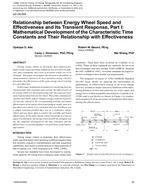Description
Testing energy wheels to determine their effectiveness under steady-state operating conditions has proved to be difficult, time consuming, and costly if accurate results are to be obtained. This paper investigates the theoretical feasibility of using transient response tests on a stationary energy wheel to determine the effectiveness of the same energy wheel rotating at a specified rate.
In this paper mathematical models for predicting first the characteristic time constants and, second, the effectiveness of an energy wheel are developed using only the expected transient response functions for the wheel. These time constants for sensible and latent (phase change) energy transient response are directly related to the corresponding sensible and latent effectiveness of an energy wheel operating at steady state at a specified rotor speed. It is concluded that it is feasible to use a simple transient parallel flow test on a stationary energy wheel and use these data to predict the sensible and latent effectiveness of the same energy wheel operating at a known speed. Furthermore, the energy wheel and HVAC designer can use the equations developed for the time constants and the effectiveness to provide guidance toward better performance and control.
Citation: ASHRAE Trans. vol. 112, pt. 2, paper no. QC-06-010, p. 89-102
Product Details
- Published:
- 2003
- Number of Pages:
- 14
- File Size:
- 1 file , 970 KB
- Product Code(s):
- D-28730




